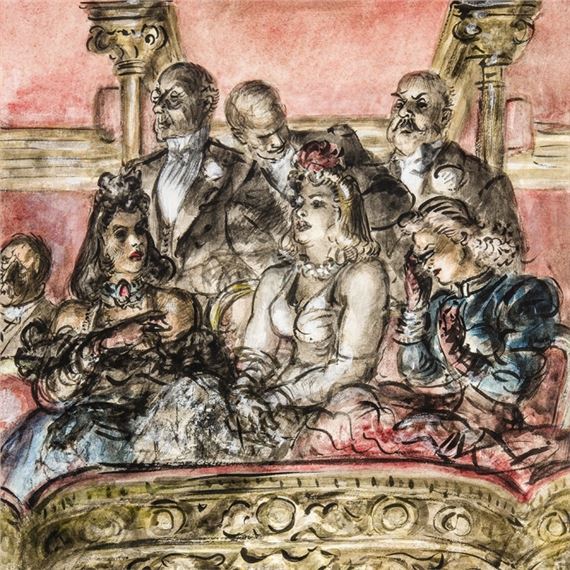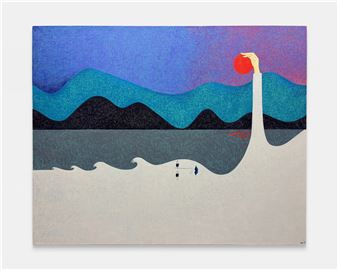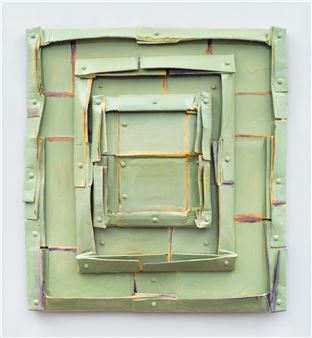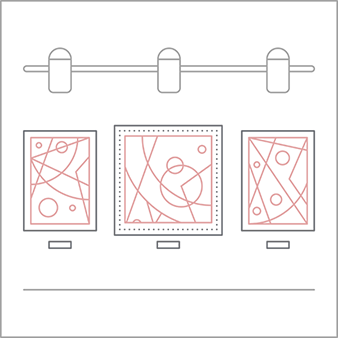The Madding Crowd: 150 Years of American Urban Landscapes
Hirschl & Adler is pleased to present its summer exhibition, The Madding Crowd, featuring American fine and decorative arts from the 19th century to the present. The Madding Crowd commemorates the city and its inhabitants, celebrating them through artistic representation. Due to the high density of people in cities, the effects of the Coronavirus pandemic and our responses to it have been intensely felt by its constituents. Quotidian city life continues to remain disrupted, but as the pandemic wanes, we hope to reflect on what cities have been through but still have to offer.
This wide-ranging selection of works represents two visions of urban life. On the one hand, some artists depict the highly organized, rational city as conceptualized by urban planners—a version visible through skyscrapers, bridges, aerials views, and mechanical structures. Consider Lawrence Edwin Blazey’s Euclid Avenue, Cleveland (about 1930), rendered in clean, architectonic lines. The high-vantage-point perspective is taken from a towering skyscraper, looking downward to the busy commercial thoroughfare dotted with vehicles and electric trolleys. Blazey’s Precisionism and daring perspective capture the dynamism and modernity of this booming center of Cleveland’s economy.
On the other hand, other works also delve into an individual’s experience within the metropolis, which is visible through various subjects, including scenes of recreation and entertainment or bustling, energetic crowds. One such crowd is seen in Andy Mister’s Disobedience. With its absence of specific signifiers of an issue or cause, the monochromatic drawing creates a timeless scene, one which beckons the viewer to imagine themselves immersed in the crowd and participating in the protest.
Artists portray the city as a place of vitalism, leisure, and liberation made possible through its organizational structures in these selections. Here too, the artists demonstrate the transitory, adaptable nature of the city and its inhabitants: progressive energy that will prove essential in our collective shift out of pandemic life. Forging connections across numerous cities, eras, and artistic styles, this exhibition offers a wealth of parallels between the contemporary viewer’s experience and the artistic distillation of city life.

Recommended for you
Hirschl & Adler is pleased to present its summer exhibition, The Madding Crowd, featuring American fine and decorative arts from the 19th century to the present. The Madding Crowd commemorates the city and its inhabitants, celebrating them through artistic representation. Due to the high density of people in cities, the effects of the Coronavirus pandemic and our responses to it have been intensely felt by its constituents. Quotidian city life continues to remain disrupted, but as the pandemic wanes, we hope to reflect on what cities have been through but still have to offer.
This wide-ranging selection of works represents two visions of urban life. On the one hand, some artists depict the highly organized, rational city as conceptualized by urban planners—a version visible through skyscrapers, bridges, aerials views, and mechanical structures. Consider Lawrence Edwin Blazey’s Euclid Avenue, Cleveland (about 1930), rendered in clean, architectonic lines. The high-vantage-point perspective is taken from a towering skyscraper, looking downward to the busy commercial thoroughfare dotted with vehicles and electric trolleys. Blazey’s Precisionism and daring perspective capture the dynamism and modernity of this booming center of Cleveland’s economy.
On the other hand, other works also delve into an individual’s experience within the metropolis, which is visible through various subjects, including scenes of recreation and entertainment or bustling, energetic crowds. One such crowd is seen in Andy Mister’s Disobedience. With its absence of specific signifiers of an issue or cause, the monochromatic drawing creates a timeless scene, one which beckons the viewer to imagine themselves immersed in the crowd and participating in the protest.
Artists portray the city as a place of vitalism, leisure, and liberation made possible through its organizational structures in these selections. Here too, the artists demonstrate the transitory, adaptable nature of the city and its inhabitants: progressive energy that will prove essential in our collective shift out of pandemic life. Forging connections across numerous cities, eras, and artistic styles, this exhibition offers a wealth of parallels between the contemporary viewer’s experience and the artistic distillation of city life.
Artists on show
- Andy Mister
- Berenice Abbott
- Childe Hassam
- Colin Brown
- Colin Campbell Cooper
- Diana Horowitz
- Edmund Quincy
- Frederick Brosen
- Hilaire Harzberg Hiler
- Jane Peterson
- John Moore
- Lawrence Edwin Blazey
- Marc Trujillo
- Nicolino Vicompte Calyo
- Purvis Young
- Reginald Marsh
- Thomas Adrian Fransioli
- William Glackens
- Winold Reiss
- Yasuo Kuniyoshi
Contact details


 ARTISTS
ARTISTS















